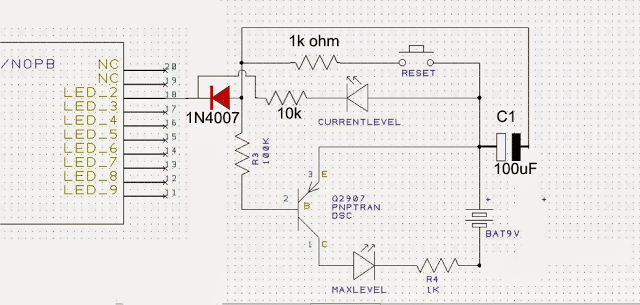In this post I have explained how to build 4 interesting VU meter circuits, using LEDs and using a moving coil meter.
What is a VU Meter
VU meter or a volume unit meter circuit is a device used for indicating the music volume output from an amplifier or a loudspeaker system. It may be also considered as a device for displaying the PMPO of the amplifier at a particular volume setting.
It is also called music level indicator circuit since the music fed to the circuit is displayed through an incrementing LED bar graph illumination, where the number of LED illuminated is directly proportional to the level of the music volume or music power.
Introduction
Though the unit looks quite technical, which is applied as a measuring device of audio power, in real terms these are more like decorative ornaments of an amplifier.
Without such devices attached, an amplifier system would look quite dull and without any juice.
The varying response from a VU meter certainly gives a whole new dimension to a sound system making it more dynamic with its features.
Prior to the days when LEDs were not so popular, moving coil meter type of displays were commonly incorporated as VU meters and surely these units with there back lights ON produced a distinctive visual effect as their needles deflected from left to right displaying the varying pitch of the connected audio system.
With the advent of the LEDs, the moving coil displays slowly got replaced with the ones which incorporated LEDs.
With color effect at its disposal, LEDs became the HOT favorites as far as VU meter were concerned, even today amplifiers employ a LED VU graph for displaying the music power in an amplifier.
For electronic hobbyists who are rather more interested in building a particular required gagdet right at home instead of buying a commercial piece, this cool VU meter circuit will interest them if they are intending to make one for their music system.
1) 20 LED VU Meter
The first circuit of a simple LED VU meter explained here uses the outstanding chip LM3915 from TEXAS Instruments.
The circuit diagram shows a very simple configuration employing two of the above ICs in the cascaded form for producing a good 20 LED sequencing bar type indication.
The music input is applied across pin #5 and ground of the IC. The music input can be directly derived from the speaker terminals of the music system.
R3 has been stationed for adjusting the typical dB levels between the LEDs for enabling visually more enhanced sequencing pattern in response to the fed music input.
The diagram shows a separate power supply being used for the circuit, however if the amplifier supports a 12 volt stabilized power supply, can be used for powering the circuit as well, this would help to get rid of the extra bulk involving the transformer and the associated rectification circuitry.
The color of the LEDs may be selected as indicated in the diagram or may be altered as desired by the user.
Everything is pretty straight forward and can be simply built over a general purpose board.
Assemble the IC first and then go on fixing the rest of the components and connect then to the relevant pin outs of the IC.
The LEDs should be soldered at the end, such that all of them are arranged in a straight line, preferably at the edge of the PCB.
An external enclosure may be used for housing the assembled circuit or possibly the circuit may be installed in the amplifier dashboard itself, if situation permits the required drilling and fittings.
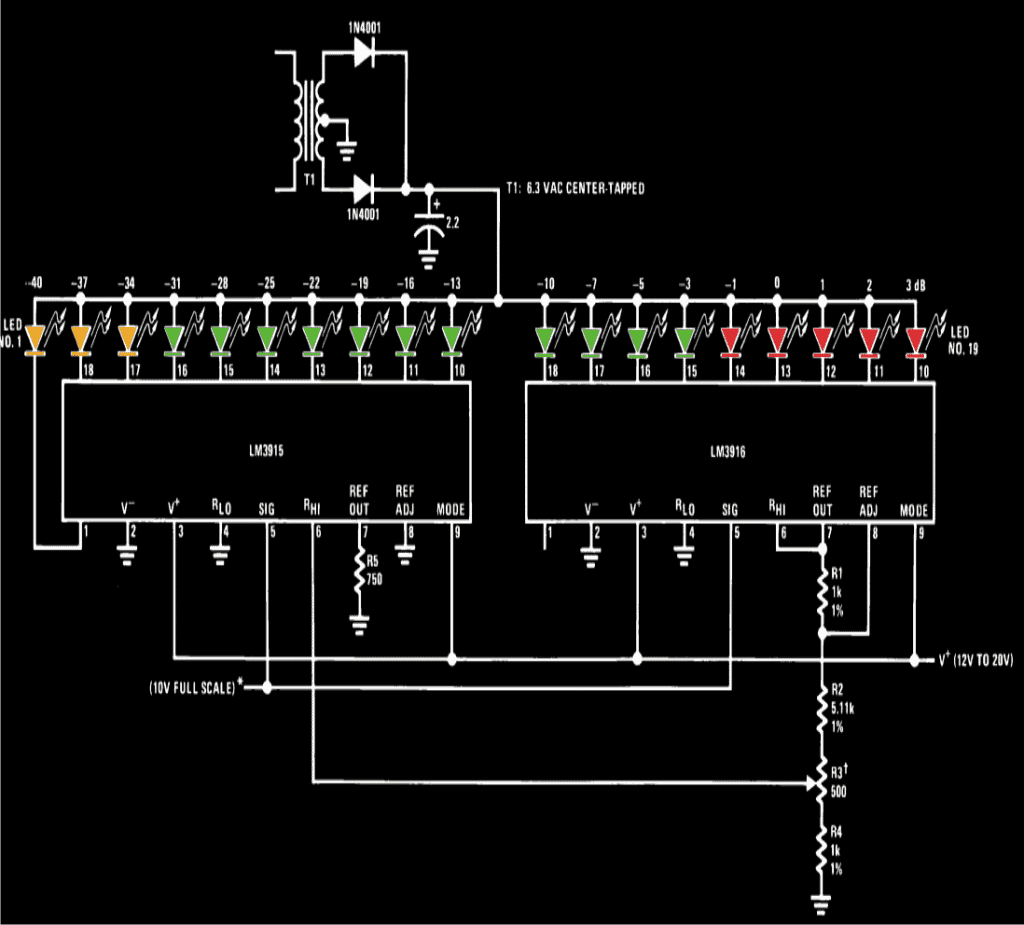
2) 10 LED VU Meter
This easy maximum music level detector VU meter circuit employs 6 LEDs to display six signal levels from -14, -8, -3, 0, +3, and +6dB, or some other quantities keeping the identical spacing.
Approximately 24 mV peak to peak is necessary to be able to illuminate the last 10th LED, thus the circuit is actually highly sensitive and perfectly suitable with any standard product of sound systems.
The circuit is configured around the IC LM3914N bargraph display driver device (IC1), which is wired to drive the attached 10 LEDs.
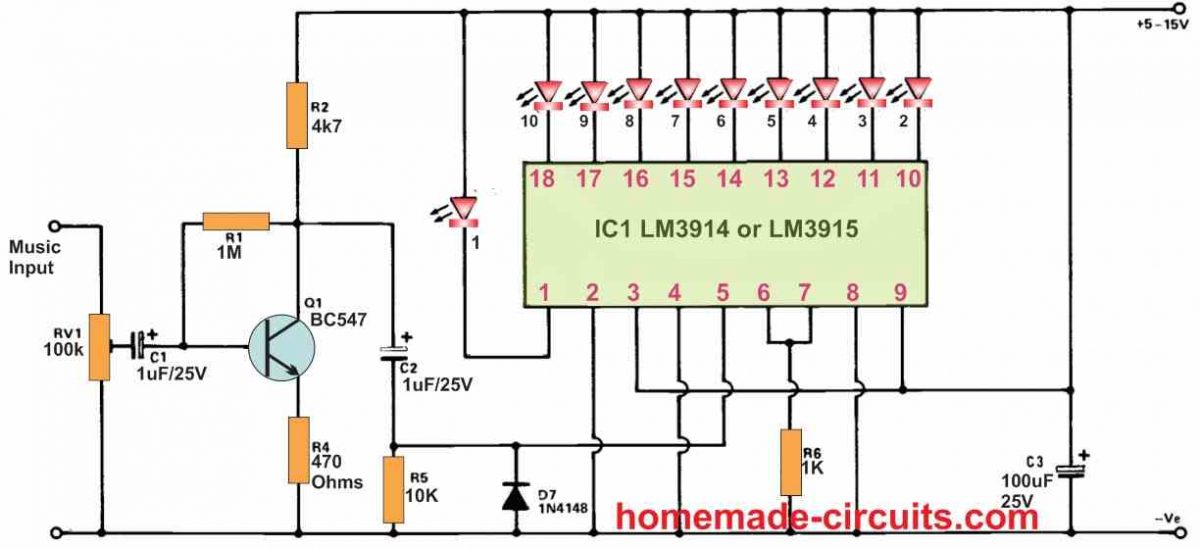
The configuration ensures that with 0.12 V music input only the first LED indicator lights. When the music input rises to 0.24 V the second LED lights up; with a 0.36 V music supply enables three LEDs to light up and so on until an input signal of 1V2 or more is reached which causes all the ten LEDs to be illuminated.
The input signal is applied to a preset for allowing the sensitivity adjustment of the circuit to the appropriate degree. The trimmed audio signal from the preset fed to a low gain common emitter amplifier constructed around the BJT Q1 which enhances a 10 times higher sensitivity for the circuit. Capacitor C2 takes the output signal from Q1 to the input of IC1.
Resistor R5 works like the input bias resistor for IC1, and diode D7 safeguards IC1 from extreme negative input voltage. Resistor R6 controls the current to every single LED and restricts it at around 12 mA.
However, because IC1 can work with only the positive half cycles of the music signal, the LEDs are able to turn on for a only 50% of time. This allows an overall current of 6 mA for each of the LEDs.
The quiescent current consumption of the VU meter is not more than 8mA, which may increase to an utmost maximum of 44 mA while all the 10 LEDs are switched ON.
Simplified Circuit
If you are not interested to have a 20 LED VU meter circuit rather satisfied with a 10 LED VU meter, then the following design using LM3915 can be very handy.
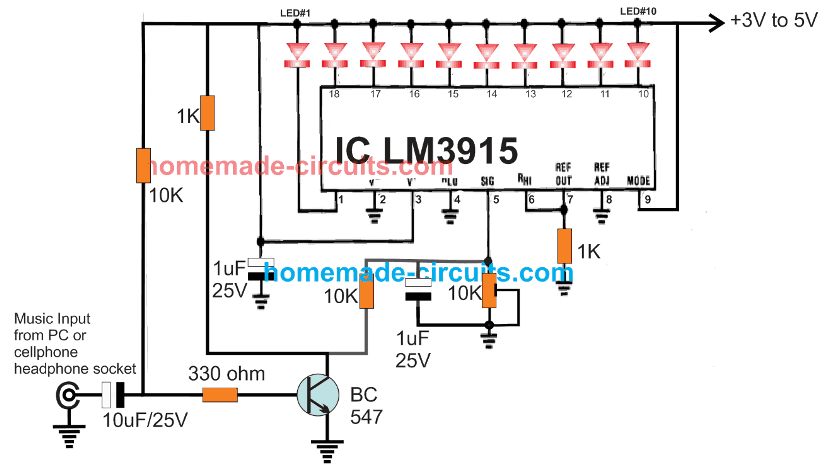
3) VU Meter using DC Voltmeter
The below given 3rd VU meter circuit will also show the music level but will indicate it through an ordinary moving coil voltmeter, as shown in the following diagram.
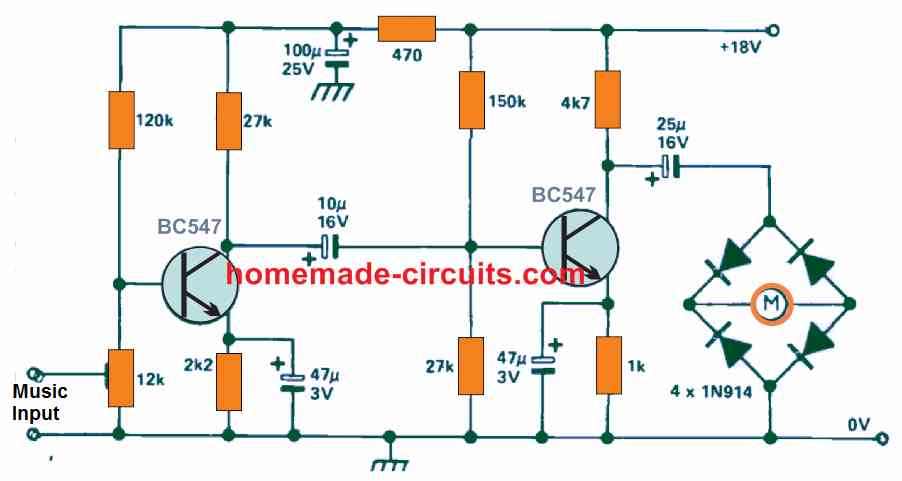
The VU meter circuit indicated in the above diagram consists of a 2-stage voltage amplifier which operates a connected a level meter. The inpu music AC signal is first amplified, and then rectified, and finally the resulting DC potential equivalent to the music level is displayed on the connected voltmeter.
The VU circuit using a voltmeter can be used with any amplifier, music system, audio mixer etc and must be connected from an early stage of the pre-amp. The current intake of the circuit in the absence of an input signal is around 2.8mA. The 12K preset can be used for adjusting the sensitivity of the circuit.
The meter M can be any general purpose moving coil voltmeter.
4) Non-Contact VU Meter
The following circuit shows the 4rth design. This 10 LED VU meter yet again uses the versatile LM3914 or LM3915 sequential LED driver for detecting and driving 10 sequential LEDs in dot mode or in bar graph mode which can be selected using the switch S1.
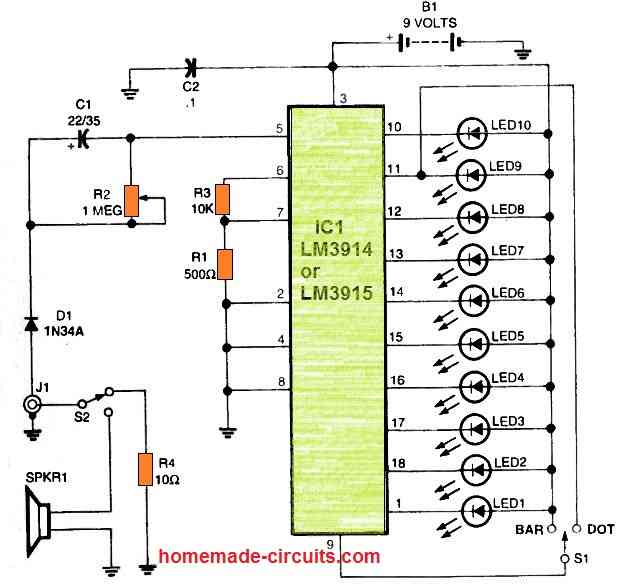
The best feature of this VU meter is that, it can be used to indicate the music levels either by directly connecting the line output of the amplifier with the J1 socket, or it can be operated without any direct connection, meaning without using physical wires for the connection.
How the wireless mode can be implemented?
It can be done through the small 8 Ohm speaker, which simply needs to kept near the amplifier loudspeaker. When the music from the loudspeaker hits the VU meter speaker SPKR1, it converts the music into tiny electrical pulses which is sensed by the LM3914 IC and appropriately converted into a sequential up/down LED movement, depending on the strength of the music from the amplifier loudspeaker.
Switch S2 can be used for selecting the direct connection mode or the wireless speaker mode.
S1 is used for enabling the LEDs to run and imitate a dot, or like a bar moving and down.
Stereo LED Music Level Indicator Circuit
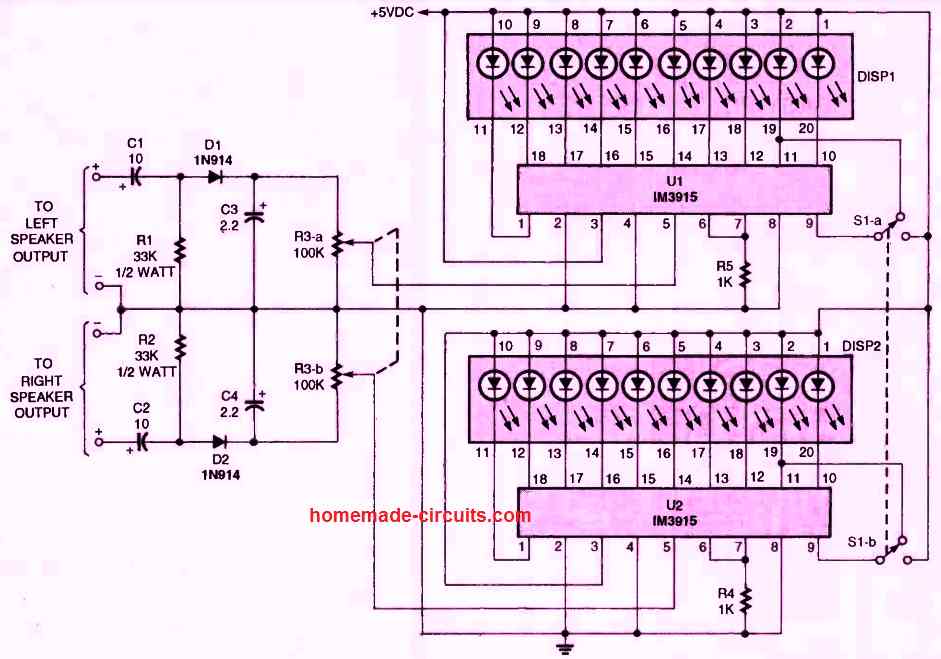
The circuit is composed of two LM3915 drivers for dot and bar displays. Due to the fact the voltage dividers, the voltage reference, and the adjustment inputs are all located within a single integrated circuit, which considerably lowers the number of components.
By cascading the LM3915s, the circuit may be extended to 20 or more sections.
In this prototype, I utilized tri-colored bargraph displays, but you can also use any color scheme for the individual LEDs or a simple 10-segment bargraph display. For the adjustment control, I additionally utilized a 100k stereo potentiometer (R3).
This prevents the need for two different adjustments and guarantees that both sides might still get an identical signal. Switch S1 alternates between dot and bar modes.
I'm not precisely sure how much power this circuit can handle; it was designed mainly for smaller stereos.
While in barmode and operating at full scale, the circuit uses about 300 mA.
You may use batteries, your own power supply, or even the supply from your stereo to power the meters, like I did. I'm hoping that anyone who had the same issues as me would find my circuit to be both intriguing and practical.
